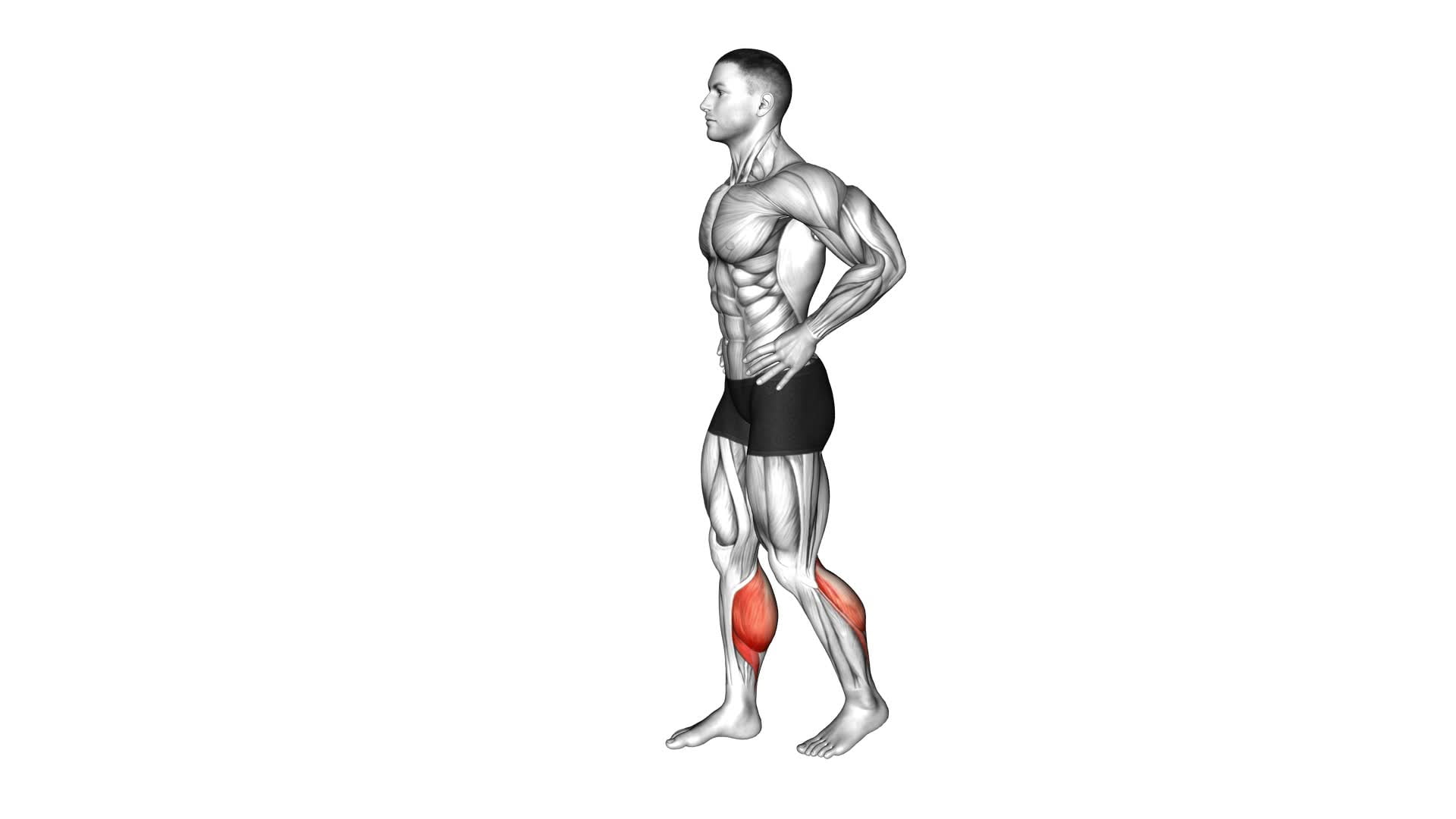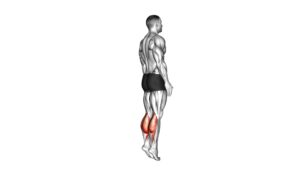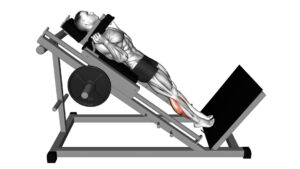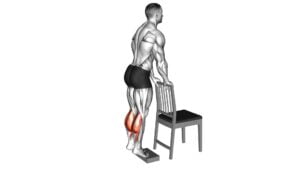Bodyweight Walking Calf Raise – Video Exercise Guide & Tips

Are you looking to strengthen your calves and improve your lower body strength? Look no further than the bodyweight walking calf raise!
Watch This Exercise Video
This simple yet effective exercise is a great way to target and tone your calf muscles without any equipment.
In this article, we'll guide you through the proper form and technique, provide variations and progressions to challenge yourself, and offer tips for a more effective workout.
Get ready to elevate your calf game and achieve those strong, sculpted legs you've always wanted. Let's get started!
Key Takeaways
- Strengthening calves improves lower body strength and stability
- Targets gastrocnemius and soleus muscles for ankle stability and mobility
- Develops explosive power for activities like jumping and sprinting
- Enhances athletic performance and reduces risk of ankle sprains
Benefits of the Bodyweight Walking Calf Raise
Experience three key benefits when incorporating the bodyweight walking calf raise into your exercise routine.
Strengthening your calves through bodyweight exercises is essential for improving your overall lower body strength and stability. By incorporating calf raises into your daily fitness routine, you can enhance your athletic performance and reduce the risk of lower leg injuries.
Firstly, the bodyweight walking calf raise targets the calf muscles, specifically the gastrocnemius and soleus. These muscles play a crucial role in ankle stability and mobility. By strengthening them, you can improve your balance and reduce the risk of ankle sprains.
Secondly, this exercise helps to develop explosive power in your lower legs. The calf muscles are heavily involved in activities that require quick, powerful movements, such as jumping and sprinting. Regularly performing the bodyweight walking calf raise will improve your ability to generate force from the calves, leading to enhanced athletic performance.
Lastly, incorporating this exercise into your routine can also improve the appearance of your calves. Strong, toned calf muscles not only look great but also contribute to a well-balanced and proportionate physique.
Now that you understand the benefits, let's move on to the subsequent section about proper form and technique to ensure you get the most out of this exercise.
Proper Form and Technique
To ensure you get the most out of the bodyweight walking calf raise, it's important to maintain proper form and technique. Here are some tips to help you do it correctly:
- Stand with your feet hip-width apart and your toes pointing forward. Keep your core engaged and your shoulders relaxed.
- Slowly raise your heels off the ground, lifting your body weight onto the balls of your feet. Keep your knees straight throughout the movement.
- Walk forward while maintaining the raised position of your heels. Take small, controlled steps to prevent any loss of balance.
- Lower your heels back down to the ground as you complete each step. Make sure to fully extend your ankles to activate your calf muscles.
Common misconceptions about the bodyweight walking calf raise include the belief that you need to lift your heels as high as possible or that speed is more important than control. However, it's crucial to focus on quality over quantity and maintain a slow and controlled movement to effectively engage your calf muscles.
Variations and Progressions
Try incorporating different variations and progressions to challenge yourself and further enhance the effectiveness of the bodyweight walking calf raise.
One advanced modification you can try is adding weight to the exercise. This can be done by holding dumbbells or wearing a weighted vest while performing the calf raise. The added resistance will help to increase muscle strength and size.
Another variation is to perform the calf raises on an elevated surface, such as a step or a sturdy block. This will increase the range of motion and engage the calves in a different way, providing a greater challenge.
If you're looking for a more dynamic version of the exercise, you can try performing the walking calf raise on a treadmill. Set the treadmill to a slow speed and walk on the balls of your feet, lifting your heels with each step. This won't only target the calves but also challenge your balance and coordination.
Incorporating these variations and progressions into your bodyweight walking calf raise routine will help you continue to challenge your muscles and see continued progress.
Next, let's discuss some common mistakes to avoid to ensure you're getting the most out of this exercise.
Common Mistakes to Avoid
To avoid common mistakes, make sure you aren't compromising proper form and technique during the bodyweight walking calf raise exercise. Here are some common mistakes to watch out for and tips on how to perform the exercise correctly:
- Rushing the movement: Many people tend to rush through the calf raise exercise, sacrificing proper form. Take your time and focus on the contraction of your calf muscles.
- Not maintaining a straight posture: It's important to keep your back straight and your core engaged throughout the exercise. Avoid leaning forward or backward, as this can put unnecessary strain on your lower back.
- Using momentum instead of muscle power: Instead of relying on momentum to lift your bodyweight, focus on using your calf muscles to perform the movement. Lift and lower your body in a controlled manner, feeling the burn in your calves.
- Neglecting the full range of motion: Ensure that you're performing the exercise through its full range of motion. Lower your heels as far as possible and rise up onto your toes as high as you can, maximizing the effectiveness of the exercise.
Tips for a More Effective Workout
Maximize your results by incorporating these tips for a more effective bodyweight walking calf raise workout.
To increase the intensity of your workout, try performing the exercise on an incline. This will place more stress on your calf muscles, making them work harder.
You can also try adding weights to your workout by holding dumbbells or wearing ankle weights. This will further challenge your calf muscles and help to build strength and endurance.
In addition to increasing the intensity, incorporating balance training into your bodyweight walking calf raise workout can also be beneficial. Balancing exercises help to improve stability and coordination, which can enhance your overall performance and reduce the risk of injury.
To incorporate balance training, try performing the calf raise exercise on an unstable surface, such as a balance board or a foam mat. This will require your calf muscles to work harder to maintain balance, increasing the challenge of the exercise.
Remember to always maintain proper form throughout your workout. Keep your core engaged, your back straight, and your shoulders relaxed. Avoid rushing through the exercise and focus on performing each repetition with control and precision.
Frequently Asked Questions
How Many Calories Does the Bodyweight Walking Calf Raise Burn?
When you do bodyweight walking calf raises, you're not only improving your calf muscles, but you're also burning calories.
While the exact number of calories burned may vary depending on factors such as weight and intensity, this exercise can be an effective way to burn calories.
Additionally, bodyweight exercises like this have numerous benefits, including improved strength, flexibility, and balance.
Can the Bodyweight Walking Calf Raise Help in Improving Balance?
The bodyweight walking calf raise is a great exercise for improving stability and increasing ankle strength. By regularly performing this exercise, you can enhance your balance and overall body control.
This exercise targets the calf muscles, which play a crucial role in maintaining balance and stability. Incorporating the bodyweight walking calf raise into your workout routine can help you develop stronger ankles and improve your overall balance.
Is It Necessary to Warm up Before Performing the Bodyweight Walking Calf Raise?
Before performing the bodyweight walking calf raise, warming up is necessary to prepare your muscles and joints for exercise. Warming up has many benefits, such as increasing blood flow and flexibility, reducing the risk of injury, and improving overall performance.
It's important to maintain proper form and technique during the exercise to target your calf muscles effectively. Make sure to keep your core engaged, shoulders relaxed, and take small steps while performing the calf raise.
Can the Bodyweight Walking Calf Raise Help in Reducing the Appearance of Cellulite?
The bodyweight walking calf raise is a great exercise for toning your calves and improving lower body strength.
While it can help strengthen your muscles, it's important to note that there's limited evidence to suggest that it can reduce the appearance of cellulite.
Cellulite is caused by fat deposits beneath the skin, and reducing cellulite typically requires a combination of healthy eating, regular exercise, and targeted treatments.
How Often Should the Bodyweight Walking Calf Raise Be Performed for Best Results?
To improve calf strength and get the best results, it's important to perform the bodyweight walking calf raise regularly. By incorporating this exercise into your routine, you can target and strengthen your calf muscles effectively.
There are also variations of calf raises that you can try to add variety and challenge to your workouts. Remember to listen to your body and start with a frequency that feels comfortable, gradually increasing as you build strength.
Conclusion
In conclusion, the bodyweight walking calf raise is a simple yet effective exercise for strengthening and toning the calf muscles.
By incorporating proper form and technique, variations and progressions, and avoiding common mistakes, you can maximize the benefits of this exercise.
Remember to focus on a full range of motion and maintain a steady pace to ensure a more effective workout.
So lace up your shoes and get ready to elevate your calf game!

Author
Years ago, the spark of my life’s passion ignited in my mind the moment I stepped into the local gym for the first time. The inaugural bead of perspiration, the initial endeavor, the very first surge of endorphins, and a sense of pride that washed over me post-workout marked the beginning of my deep-seated interest in strength sports, fitness, and sports nutrition. This very curiosity blossomed rapidly into a profound fascination, propelling me to earn a Master’s degree in Physical Education from the Academy of Physical Education in Krakow, followed by a Sports Manager diploma from the Jagiellonian University. My journey of growth led me to gain more specialized qualifications, such as being a certified personal trainer with a focus on sports dietetics, a lifeguard, and an instructor for wellness and corrective gymnastics. Theoretical knowledge paired seamlessly with practical experience, reinforcing my belief that the transformation of individuals under my guidance was also a reflection of my personal growth. This belief holds true even today. Each day, I strive to push the boundaries and explore new realms. These realms gently elevate me to greater heights. The unique combination of passion for my field and the continuous quest for growth fuels my drive to break new ground.







